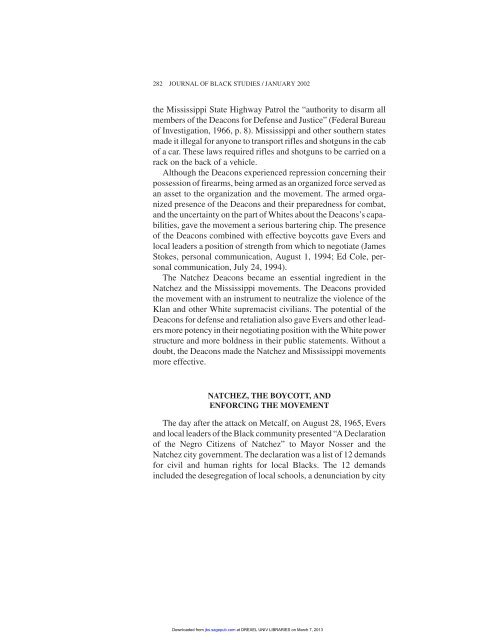MXGM Self-Defence Manual
MXGM Self-Defence Manual
MXGM Self-Defence Manual
Create successful ePaper yourself
Turn your PDF publications into a flip-book with our unique Google optimized e-Paper software.
282 JOURNAL OF BLACK STUDIES / JANUARY 2002<br />
the Mississippi State Highway Patrol the “authority to disarm all<br />
members of the Deacons for Defense and Justice” (Federal Bureau<br />
of Investigation, 1966, p. 8). Mississippi and other southern states<br />
made it illegal for anyone to transport rifles and shotguns in the cab<br />
of a car. These laws required rifles and shotguns to be carried on a<br />
rack on the back of a vehicle.<br />
Although the Deacons experienced repression concerning their<br />
possession of firearms, being armed as an organized force served as<br />
an asset to the organization and the movement. The armed organized<br />
presence of the Deacons and their preparedness for combat,<br />
and the uncertainty on the part of Whites about the Deacons’s capabilities,<br />
gave the movement a serious bartering chip. The presence<br />
of the Deacons combined with effective boycotts gave Evers and<br />
local leaders a position of strength from which to negotiate (James<br />
Stokes, personal communication, August 1, 1994; Ed Cole, personal<br />
communication, July 24, 1994).<br />
The Natchez Deacons became an essential ingredient in the<br />
Natchez and the Mississippi movements. The Deacons provided<br />
the movement with an instrument to neutralize the violence of the<br />
Klan and other White supremacist civilians. The potential of the<br />
Deacons for defense and retaliation also gave Evers and other leaders<br />
more potency in their negotiating position with the White power<br />
structure and more boldness in their public statements. Without a<br />
doubt, the Deacons made the Natchez and Mississippi movements<br />
more effective.<br />
NATCHEZ, THE BOYCOTT, AND<br />
ENFORCING THE MOVEMENT<br />
The day after the attack on Metcalf, on August 28, 1965, Evers<br />
and local leaders of the Black community presented “A Declaration<br />
of the Negro Citizens of Natchez” to Mayor Nosser and the<br />
Natchez city government. The declaration was a list of 12 demands<br />
for civil and human rights for local Blacks. The 12 demands<br />
included the desegregation of local schools, a denunciation by city<br />
Downloaded from jbs.sagepub.com at DREXEL UNIV LIBRARIES on March 7, 2013


